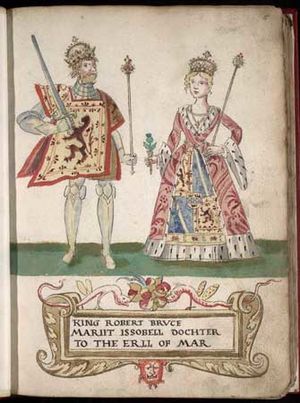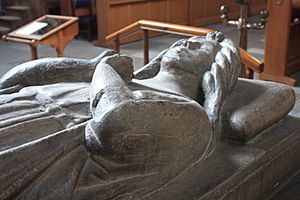Isabella of Mar facts for kids
Quick facts for kids Isabella of Mar |
|
|---|---|
| Countess of Carrick | |

Isabella and her husband, Robert the Bruce, as shown in a 1562 book. It shows her husband as King of Scotland.
|
|
| Born | c. 1277 |
| Died | 12 December 1296 (aged 18–19) |
| Spouse | Robert the Bruce, Earl of Carrick |
| Issue | Marjorie Bruce |
| House | Clan Mar |
| Father | Domhnall I, Earl of Mar |
| Mother | Elena, daughter of Llywelyn the Great |
Isabella of Mar (born around 1277 – died 12 December 1296) was the first wife of Robert the Bruce, who later became a famous Scottish king. Sadly, Isabella passed away before her husband was crowned King of Scotland. She and Robert were the grandparents of Robert II, King of Scotland, who started the Royal House of Stuart.
Isabella was the daughter of Domhnall I, Earl of Mar and Elena, who was the daughter of Llywelyn the Great. Isabella's father was a supporter of Robert Bruce V, Lord of Annandale, who wanted to become King of Scotland. The close link between Isabella's family, Clan Mar, and the Clan Bruce was shown by two marriages. First, Isabella married Robert Bruce. Second, Isabella's brother, Gartnait, Earl of Mar, married Robert Bruce's sister.
Robert Bruce and Isabella likely married in the 1290s. They had one child, a daughter named Marjorie Bruce, who was born around 1296. Marjorie later married Walter Stewart, 6th High Steward of Scotland. Their son eventually became Robert II, King of Scotland.
Six years after Isabella's death, Robert Bruce married his second wife, Elizabeth de Burgh.
Contents
Scotland's Great Challenge
As the daughter of an Earl, Isabella's life was closely connected to the important events in her country. In 1286, a few years after she was born, King Alexander III died suddenly. His only heir, Margaret, Maid of Norway, was too young to rule. Four years later, in 1290, Margaret also died at age seven.
This led to Scotland's biggest problem over who should be king. This event, known as the "Great Cause," eventually led to Robert Bruce becoming king and the Scottish Wars of Independence. After Margaret's death, Scottish nobles supported two main families who wanted the throne: the House of Balliol and the House of Bruce. Isabella's future, and the future of Scotland, depended on these two powerful families.
Clan Mar and the Bruce Family
Around this time, Isabella's father, Domhnall I, Earl of Mar, needed a strong friend to protect his clan. They faced problems with their neighbors, especially John Comyn of Badenoch. Domhnall claimed the Comyns had attacked his lands. He wanted a reason to fight them. Since the Comyns strongly supported John Balliol for the throne, Domhnall found a natural friend in the Bruce family.
A writer named John of Fordun explained that the Comyns supported Balliol. But the Earls of Mar and Atholl, with all their power, strongly supported Robert Bruce. Domhnall quickly gathered an army after Margaret's death, ready to help his new friends. This big argument over who should be king, called the "Great Cause," brought Isabella's family and the Bruce family together.
Isabella's father wanted to use Isabella's marriage to make his ties with the powerful Bruce family even stronger. The succession dispute and their support for Bruce brought them new enemies. So, Domhnall felt a lot of pressure to create a strong bond with new friends who could protect his family. In the Middle Ages, this often meant a diplomatic marriage.
The best choice for Isabella's husband was the young Robert the Bruce. He was the Earl of Carrick and would later become King of Scots. He was also the grandson of Robert de Brus, 5th Lord of Annandale, who was trying to become king at that time. Domhnall saw the young Earl of Carrick as a possible future king. By arranging Isabella's marriage to Bruce, Domhnall was not only strengthening his alliances but also marrying into a powerful family that might one day rule Scotland. Like many noblewomen in the medieval age, Isabella was used by her father to help his political plans.
The Bruce family also had political reasons for wanting to marry Isabella. North of the Earldom of Mar was the lordship of Garioch. This land was divided among four different owners, including the Bruce family. Two other owners were John Balliol and John Hastings, 1st Baron Hastings, who would later fight Bruce for the throne.
In April 1290, Bruce made a deal to gain more of Garioch. But this plan didn't work out. So, Bruce looked to Clan Mar for help. As historian Michael Brown wrote, the Earl of Mar's lands bordered Garioch, and he had lands there as Balliol's vassal. This shared interest in land likely made the Mar and Bruce families closer. Their connection was made official through marriage. Even before the fight for the throne, the Bruce family wanted to marry into Clan Mar to strengthen their claim on Garioch. Their interests became even more connected when Margaret died and Balliol became a rival. So, Isabella's marriage to Bruce was for political reasons. The two clans shared enemies and wanted to make their political ties stronger through marriage.
Robert the Bruce and Marjorie Bruce
Isabella died soon after her marriage to Robert the Bruce. But she gave birth to their daughter, Marjorie Bruce, first. We don't have many details about Isabella's death. However, it is likely she died during or shortly after Marjorie's birth in 1296. Dying during childbirth was common in the medieval age. As historian Jennifer Edwards noted, childbirth was "dangerous for all women."
However, Isabella's early death, at around 19 years old, was unusual even then. Most women who died during childbirth were older. Isabella's death during her first pregnancy was very early for the time.
The year Marjorie was born (1296) was a difficult time for her father. On March 26, 1296, seven Scottish earls attacked Carlisle Castle, where Bruce lived. The attack failed, but it made King Edward I of England very angry with the Scots. In 1296, John Balliol became King of Scots, chosen by nobles selected by Edward. But Balliol soon made an alliance with France, Edward's enemy.
Edward saw this "Auld Alliance" as a betrayal. With the attack on Carlisle, he lost patience. He marched his armies north in March 1296, starting the Wars of Scottish Independence. Edward won big victories and removed John Balliol from the throne. By July 1297, Bruce had joined the fight against the English. After many defeats, Edward signed a treaty in exchange for an oath of loyalty. Because Bruce often changed sides, Edward demanded that the infant Marjorie be given as a hostage. This was to guarantee her father's loyalty.
We don't know much about what happened next. Bruce never gave Marjorie to Edward. It's a mystery why Edward didn't punish this disobedience. Perhaps Edward had more important things to deal with. William Wallace, a Scottish leader, had not signed the treaty and was still fighting. Wallace suffered a huge loss at Falkirk, and the revolt ended. Edward then went back to England, seemingly happy with his victories. He made no more demands for Marjorie.
Bruce remained loyal to Edward until February 10, 1306. On that day, he had a deadly confrontation with his rival, John Comyn, at a church in Dumfries. With his rival defeated, Bruce broke his loyalty to Edward. He attacked the English soldiers at Dumfries Castle. Later that year, on March 25, 1306, Bruce was crowned King of Scots. Edward marched north that spring to remove his former ally.
Even though Bruce lost most of his first battles as King, he always managed to escape Edward. In June 1306, Edward's forces badly defeated Bruce at the Battle of Methven. To keep his family safe, Bruce sent word to his brother, Neil, and the Earl of Atholl. He asked them to take Marjorie and his wife to Kildrummy Castle until it was safe. They lived there for a few months.
In September 1306, Edward II, the Prince of Wales, attacked the castle. The Scots were outnumbered and suffered another defeat. This time, there was nowhere to run. The Scottish lords at Kildrummy were captured and executed, including Neil Bruce. However, the quick-thinking Earl of Atholl escaped. He took Robert's wife, his sister, and Marjorie into hiding. Days later, they were betrayed by William II, Earl of Ross, who supported Balliol. He handed Atholl and the Bruces over to the English. The Earl of Atholl was executed. Queen Elizabeth and the twelve-year-old Marjorie were captured alive. They were held as prisoners for almost ten years.
Details of Marjorie's time as a prisoner are scarce. We know that a special enclosure was built for her outside the Tower of London. This enclosure was likely similar to the one made for Isabella MacDuff, Countess of Buchan. MacDuff's enclosure was placed in public view outside Berwick Castle. It was a warning to rebels and perhaps a way to make Bruce come out of hiding.
Marjorie's aunt, Mary Bruce, was held in a similar public enclosure. She suffered from the weather and public shame. However, Marjorie was spared this harsh treatment. Perhaps Edward felt the humiliation of Mary and MacDuff was enough. Instead, Edward sent Marjorie to a convent in Watton, East Riding of Yorkshire. She lived there in quiet isolation for the next seven years.
Bruce fought for seven more hard years for his family and his crown. This led to the famous Battle of Bannockburn. In this battle, the Scots won against an English army much larger than theirs. During the fight, the English Earl, Humphrey de Bohun, 4th Earl of Hereford, was captured. Bruce used this important Earl to get Marjorie released.
In October 1314, the two sides met. They exchanged the English Earl for the Scottish Princess. Bruce himself was not there for the exchange. Instead, he sent the young Walter Stewart. Walter was a hero of Bannockburn and the 6th High Steward of Scotland. He went to the Anglo-Scottish border to bring Marjorie and her family home. Walter and Marjorie, who were about the same age, clearly liked each other. The following year (1315), they married. With this marriage, the families of Bruce and Stewart joined together.
Robert II and the Stewart Family
Marjorie became pregnant soon after marrying Walter Stewart. But she did not live to see her child grow up. There are different stories about what happened. The most common one says that Marjorie was riding her horse while pregnant. Her horse suddenly threw her off onto the road. This caused her to go into labor too early. Like her mother, Isabella, Marjorie died at the young age of twenty. However, her child, Robert II, was born alive and healthy.
Robert the Bruce did remarry to Elizabeth de Burgh. He also had a young son with her, David II. But David was the last of the House of Bruce to be king. Even though David married several women and had many mistresses, he died in 1371 without any children. Since David was Robert's only male heir, Isabella's descendants became the next in line for the throne. Isabella's grandson and Marjorie Bruce's son, Robert II, became king after his uncle David died without children. He continued the Bruce family line as the first Stewart king.
Sources




